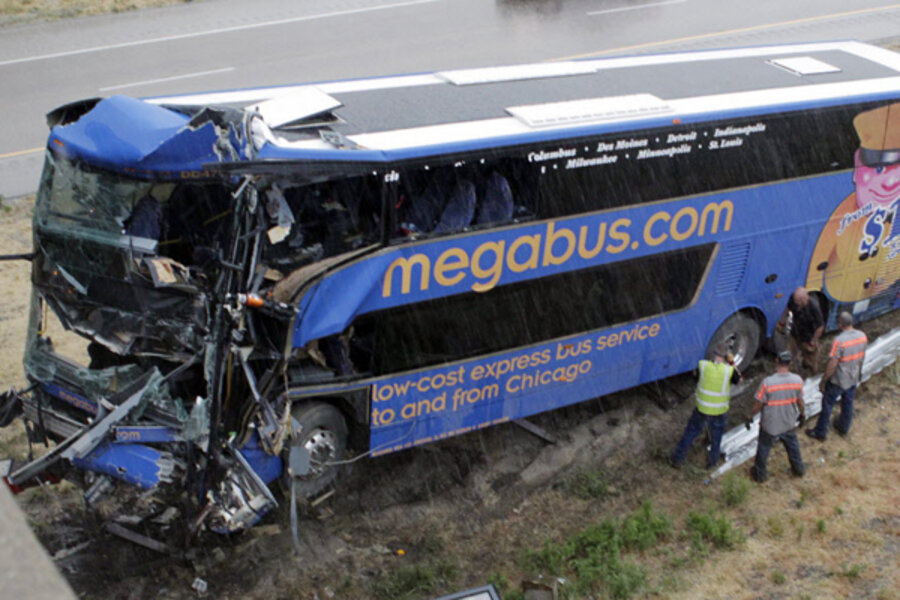Illinois Megabus crash: Bus made in 2011, inspected days ago
Loading...
| LITCHFIELD, Ill.
The bus that slammed into a southern Illinois highway overpass support, killing an Indian graduate student and injuring dozens of other passengers, was manufactured last year and passed a company safety inspection a few days ago, a bus line official said Friday.
The double-decker bus, which veered into a overpass support Thursday near Litchfield, about 55 miles northeast of St. Louis, was made by Belgium-based company Van Hool in 2011 and passed a full preventative maintenance check within the past week, Megabus spokeswoman Amanda Byers said.
Investigators on Friday were looking into passenger reports that the bus blew a tire just before it crashing. State Police Trooper Jim Holliday said a preliminary report on the cause of the crash could be completed by later Friday.
The National Highway Traffic Safety Administration said in a statement it was monitoring the investigation "to determine if there are safety implications that merit agency action."
The bus was travelling from Chicago to Columbia, Mo., then on to Kansas City, Mo. There were 81 passengers on board, putting it at full capacity, Byers said.
University of Missouri student Aditi R. Avhad, 25, a native of Mumbai, India, was killed. Illinois State Police Trooper Brad Lemarr said she was headed to Columbia, where the university is located. The school said Friday that Avhad was a graduate student in health administration.
At least 38 people — nearly half of those on the bus — were taken to hospitals and at least five who were transported by helicopter, Trooper Doug Francis said. Byers said the bus driver had surgery and his injuries aren't believed to be life-threatening.
Bus passengers gave harrowing accounts.
The impact of the accident was so powerful that it flung 16-year-old passenger Baysha Collins from the upper-level seat where she was resting to a stairway leading to the lower level.
From there, she heard moaning from her fellow passengers on the double-decker bus, the front end of which was so mangled from the collision that emergency crews had to use ladders to rescue those trapped inside.
"There was a lot of screaming and crying," said Collins, of Minneapolis, who was on her way to St. Louis to visit relatives. "There was blood everywhere. I was just in shock."
Collins, who was among the three-dozen passengers taken from a crash site to a community center in Litchfield, said she first heard a "big boom," as if the wheel was skidding.
"It felt like the bus was going to tip over," she said.
Janis Johns, transportation director of Litchfield Community Unit School District 12, said the passengers brought to the community center were either uninjured or mildly injured and included some children.
By evening, many of the uninjured passengers already had been taken by bus from the community center to St. Louis. Others were picked up by relatives, including 27-year-old Megan Arns of St. Charles, Mo., a St. Louis suburb. Her parents made the 70-mile trip to get her.
Arns was on the top deck of the bus near the back talking to a woman next to her when "all of a sudden it felt like the bus ran over something really, really big." She said she could feel the bus lose control as it rolled into the median and toward the pillar.
"Absolute panic. People were screaming," said Arns, who got away with just a scrape on her head.
Arns and 22-year-old Enrique Villaroel of Chicago said passengers began helping each other almost immediately after the wreck.
"Panic at first, then total calm," Villaroel said. "Some people were carrying other people off the bus."
Villaroel said he also was on the upper level of the bus sleeping when he was awakened by screams. "I flew out of my seat and a little girl flew past me," he said, adding that the child appeared to be OK and he escaped with a few bruises.
A string of crashes involving low-fare buses in recent years have prompted calls for tougher regulation. Four passengers were killed in September 2010 when the driver of a double-decker Megabus smashed into a low bridge outside downtown Syracuse, N.Y. The driver was acquitted earlier this year of homicide in the deaths.
Fifteen people were killed in May 2011 when a bus swerved off Interstate 95 in New York City and was sliced in two. Two days later, another bus drove off the New Jersey Turnpike and struck a bridge support, killing the driver and passenger.
But in a statement, Megabus said it has the highest-possible rating from the Federal Motor Carrier Safety Administration. The company, a subsidiary of Coach USA, said it has served 19 million passengers since it launched in April 2006.
Megabus drivers are required to take nine hours off between scheduled driving duties, the company said, which is stricter than federal requirements. The drivers also go through what the company called extensive classroom and behind-the-wheel training.







